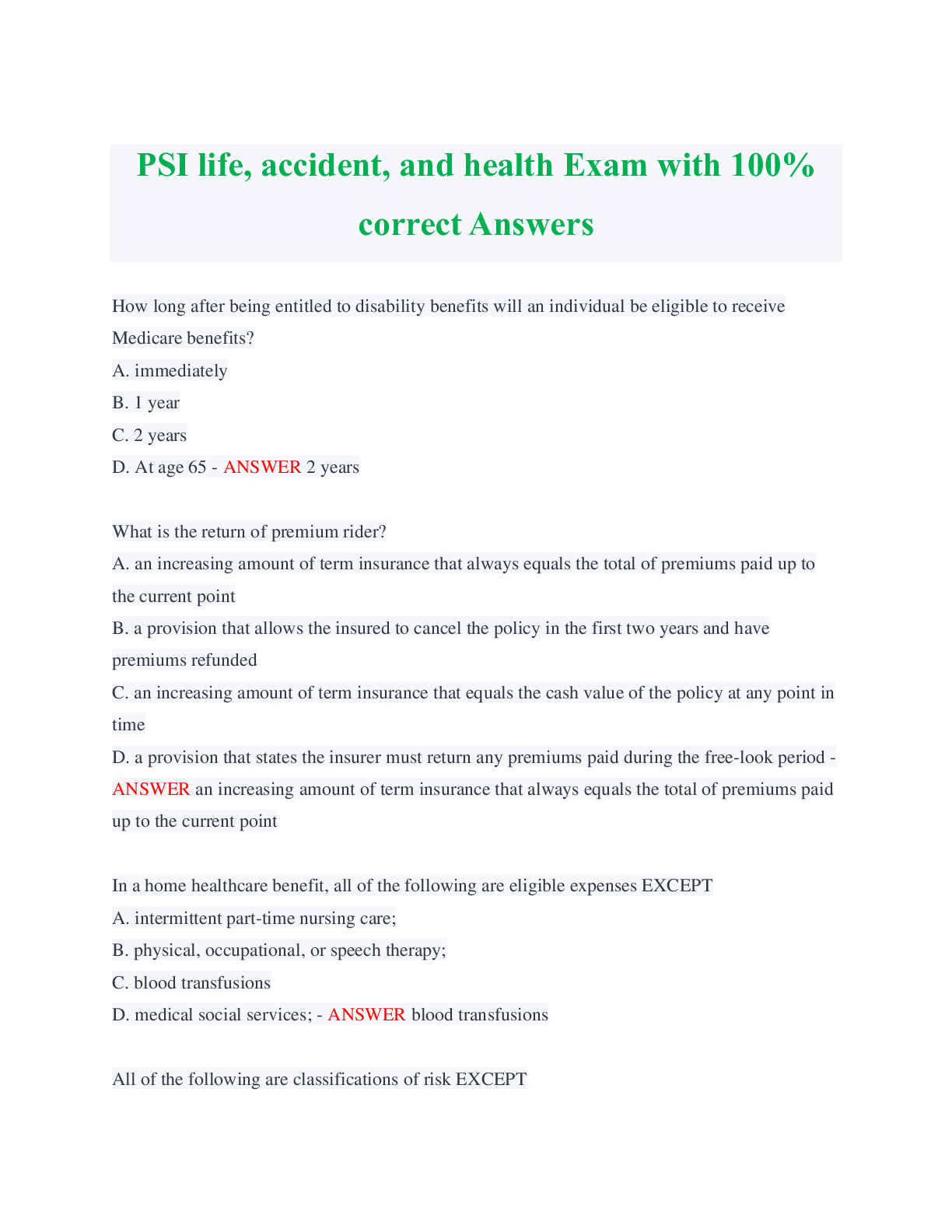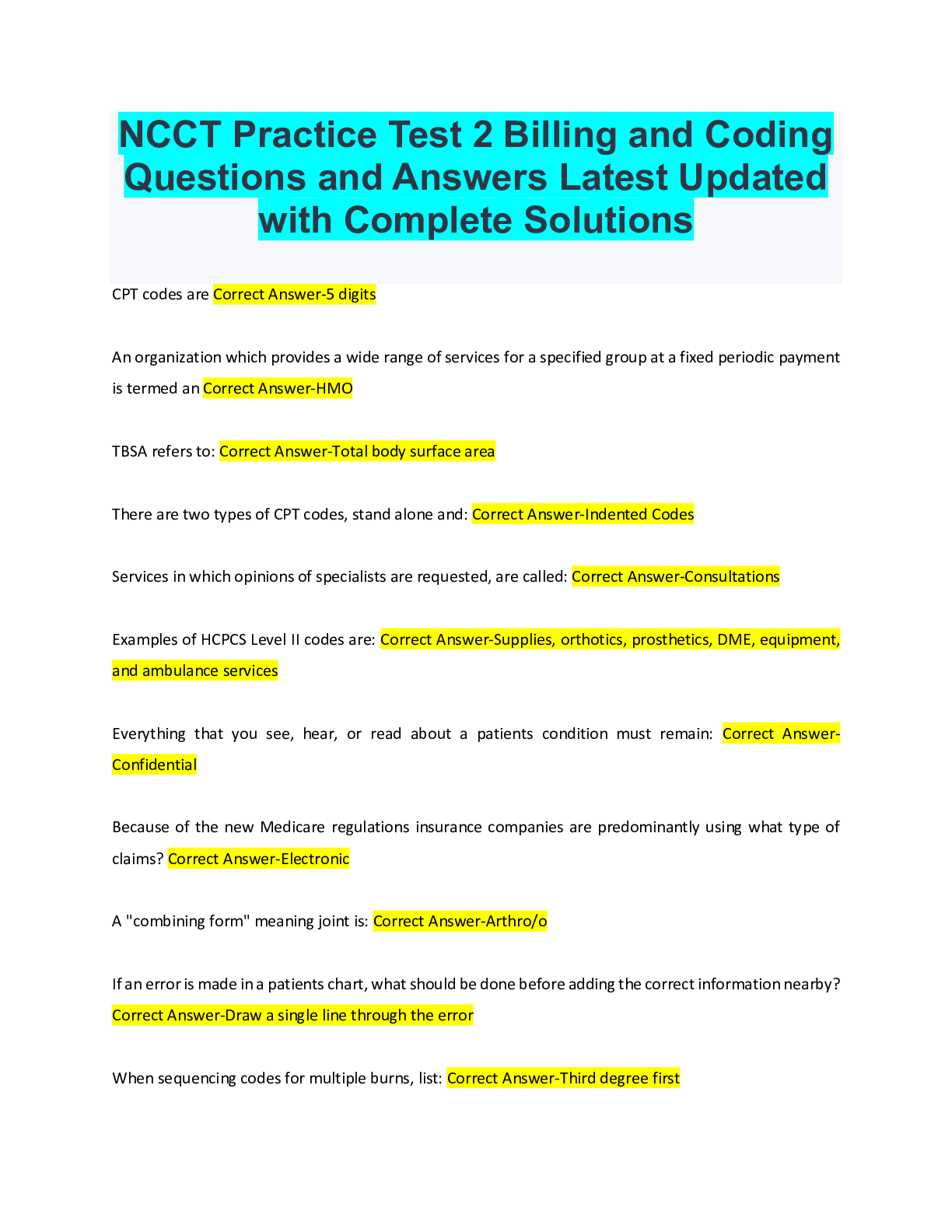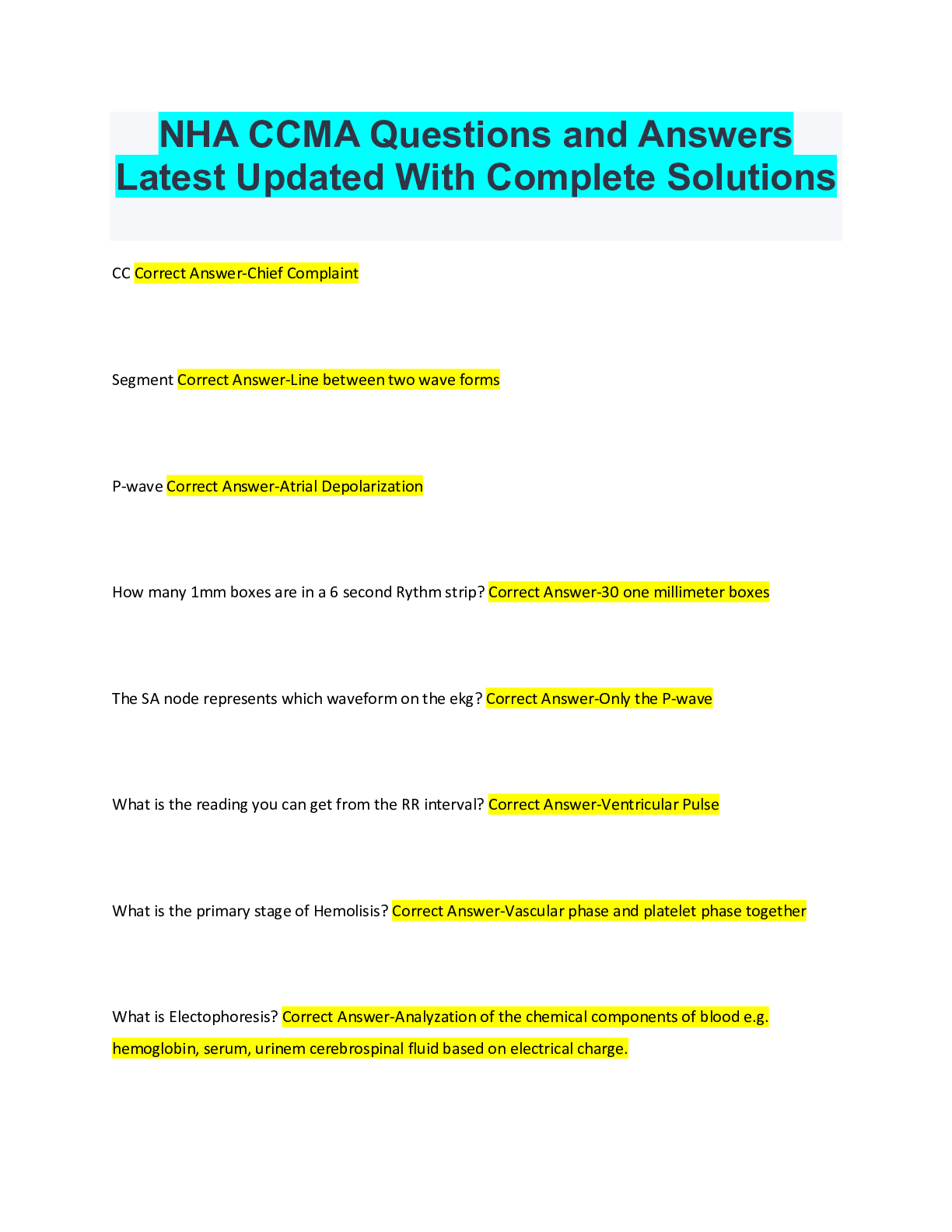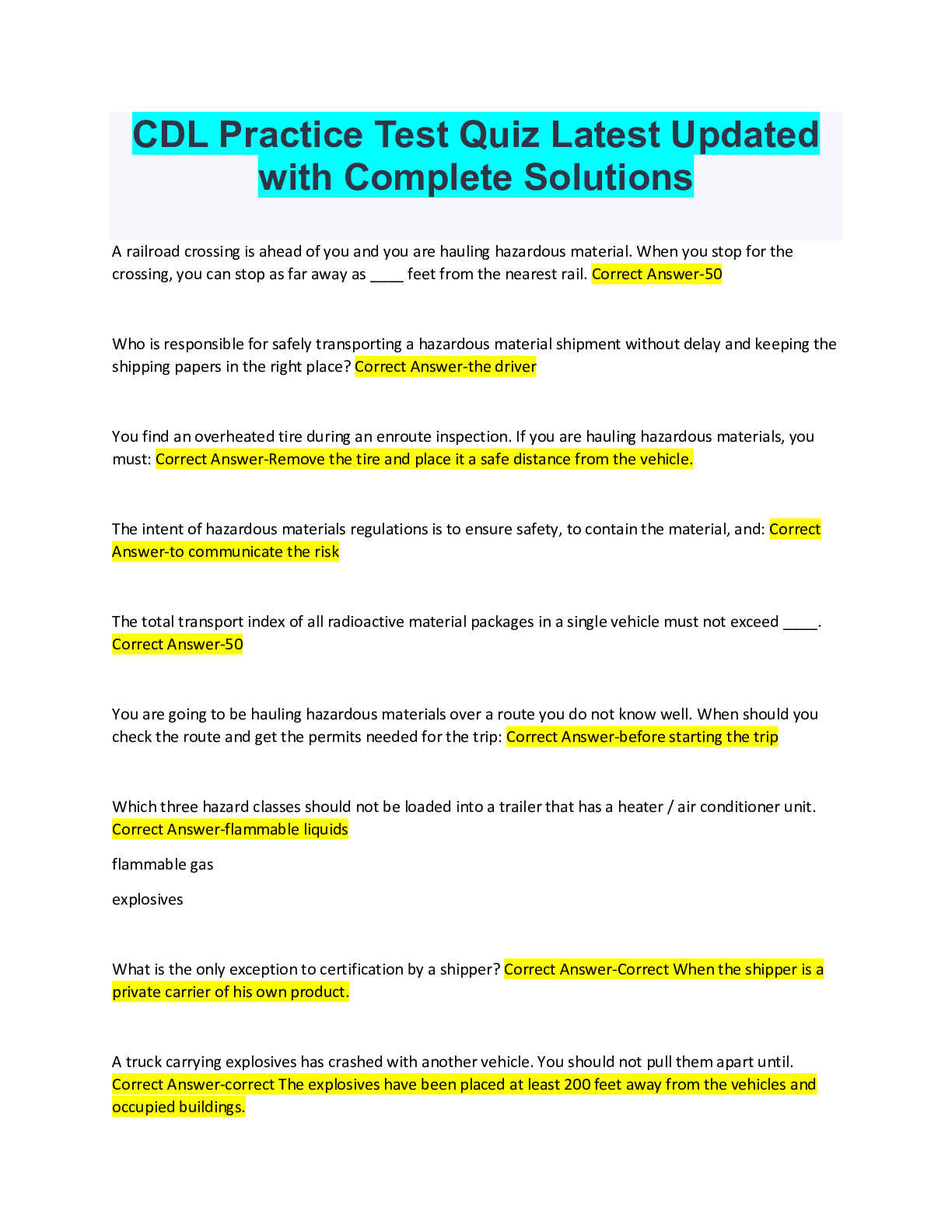LETRS Unit 1-8 Assessment Test latest Updated with Comprehensive solution
Document Content and Description Below
b. The Three Cueing Systems model omits or obscures the role of phonology. - ANSWER What is one important distinction between the Four-Part Processing Model for Word Recognition and the Three Cueing S... ystems model? a. The Four-Part Processing Model emphasizes visual processes. b. The Three Cueing Systems model omits or obscures the role of phonology. c. The Three Cueing Systems model emphasizes the role of phonology. d. The Three Cueing Systems model omits semantic processing. d. both foundational reading skills and oral language development - ANSWER Many students at risk for reading problems enter school without exposure to the academic language used in books or preschool experience. These students are most likely to make progress closing the reading and language gap if their classroom instruction emphasizes which of the following? a. oral language comprehension and reading aloud b. attending to context, including semantic and syntactic cues c. matching students with interesting reading material d. both foundational reading skills and oral language development a. early alphabetic - ANSWER A beginning first-grade student is able to segment and pronounce the first sound in a spoken word. He tries to guess at words by looking at the first letter only. When he writes words, he spells a few sounds phonetically, but not all the sounds. According to Ehri, this student is most likely in which phase of word-reading development? a. early alphabetic b. later alphabetic c. prealphabetic d. consolidated alphabetic b. phonology - ANSWER A kindergarten teacher is having students listen to three spoken words and identify the two words that end with the same sound. The teacher is focusing on which language system? a. morphology b. phonology c. orthography d. semantics d. Determine if the students need remediation in word recognition, language comprehension, or both. - ANSWER Considering the Simple View of Reading, what would be the BEST course of action for a third-grade teacher with concerns about several students who have not achieved fluency? a. Observe whether students are able to work on several subskills at once. b. Verify that students have been engaged in independent reading at home for 20 minutes every day. c. Increase demand on students to improve their passage reading rate. d. Determine if the students need remediation in word recognition, language comprehension, or both. a. primary difficulties with phonology, decoding, and word recognition - ANSWER In any first-grade classroom in a typical school in the United States, approximately one-third of students are likely to score in the "basic" or "below basic" range. The largest proportion of those students is likely to show which characteristics? a. primary difficulties with phonology, decoding, and word recognition b. primary difficulties with phonology only c. primary difficulties with automatic word recognition only d. primary difficulties with language comprehension only b. Reading problems can be treated as easily in third grade as in first grade. - ANSWER Which of the following statements is FALSE with regard to an effective implementation of a multi-tiered system of supports (MTSS)? a. It is possible for 95 percent of kindergarten students to meet benchmark by the end of the year. b. Reading problems can be treated as easily in third grade as in first grade. c. Progress-monitoring assessments should be brief, curriculum based, and economical. d. Students can learn to read even if there is little help available at home. b. both regular and irregular words - ANSWER . One important goal of beginning reading instruction is the development of a sight vocabulary that enables the student to recognize a word instantly, without having to decode it. What types of words should make up a student's sight word vocabulary? a. phonetically irregular words b. both regular and irregular words c. phonetically regular words d. high-frequency words b. They can predict which students are at long-term risk for reading failure. - ANSWER What is the value of data provided by screening measures? a. They can demonstrate the reliability of test results on repeated administrations. b. They can predict which students are at long-term risk for reading failure. c. They can determine which students need a referral to special education. d. They can contribute to teacher evaluations. b. It is morphophonemic. - ANSWER In comparison to other alphabetic languages, what feature of the English writing system makes English more difficult for young students to read and spell? a. It is syllabic. b. It is morphophonemic. c. It is a shallow orthography. d. It is phonetically transparent. b. semantics - ANSWER A second-grade teacher, in preparation for reading a new text about honeybees, asks the students to brainstorm all the meanings they know for the word comb. The teacher is primarily focusing on which language system? a. phonology b. semantics c. orthography d. morphology c. Skilled readers perceive all letters when they read. - ANSWER Experiments that use modern eye-movement technology to investigate what the eye "sees" when a proficient reader scans and comprehends a text have made what important discovery? a. Good readers skim a text, perceiving just a few letters. b. Good readers are dependent on context to identify words. c. Skilled readers perceive all letters when they read. d. The perceptual span of a good reader is triple that of a poor reader. Unit 2 Phonological processor - ANSWER Which works with speech sounds Phonological awareness - ANSWER Awareness of all levels of the speech sound system is the foundation for reading and spelling. the ability to reflect on and manipulate the sound structure of spoken language Phonological awareness - ANSWER The ability to identify think about and manipulate units of spoken language is the underpinning for processing reading language symbols. Like syllables, part of syllables called unsaid and rimes, and Phonemes is, the smallest segment of speech that combined to make new words. Four-Part processing model for Word Recognition Number 1: Phonological processor - ANSWER Helps you understand and produce oral language Four-Part processing model for Word Recognition Number 2: Orthographic processor - ANSWER Helps you connect words with your visual forms Four-Part processing model for Word Recognition Number 3: Meaning processor - ANSWER Is your internal dictionary of word definition Four-Part processing model for Word Recognition Number 4: Context processor - ANSWER Helps you use context to understand what a word means So the four processors from the Four-Part processing model work in isolation. True or False - ANSWER False they don't work in isolation they interact If you've heard a word spoken in your environment, you will recognize that word more rapidly when you see it in print. How? - ANSWER This requires coordination between the phonological and orthographic processors. If you know what they were means and I have seen it in print, you can recognize or recall its pronunciation more automatically. How? - ANSWER In this instance, the meaning processor, orthographic processor, and phonological processor work together. If you analyze the syllables in individual sounds in the word, the words meaning can be more easily stored in semantic memory. - ANSWER This activate the phonological processor and meaning processor. If you can analyze and manipulated the specific sounds in spoken words, the corresponding printed words Will be easier to remember for reading and spelling. How? - ANSWER This activate the final logical in orthographic processors. Phonological awareness - ANSWER conscious awareness of all levels of speech sound system, including word boundaries, stress patterns, syllables, unset-rimes unit, and phonemes. Phonological processing - ANSWER Multiple functions of speech and language position in production, such as perceiving, interpreting, storing (remembering), recalling her retrieving, and generating the speech sound system of language. Phoneme - ANSWER In any language, the smallest unit of sound used to build words. Phonemic awareness - ANSWER Conscious awareness that words are made up of segment of our own speech that are represented with letters in an orthopedic orthography. Phonology - ANSWER The rule system in the language by which phones can be sequenced, combined, and pronounce to make words. Phonetics - ANSWER The study of sounds of human speech; articulatory phonetics refers to the way the sounds are physically produced in the human vocal track. Phon - ANSWER The Greek root meaning vocal sound voice, sound Phonological processor - ANSWER Allows us to perceive, remember, interpret, and produce the speech sound system of our language——and learn the sounds of other languages. Phonological processor - ANSWER Analyzes the sounds so we can learn to associate phonemes with their written representations, also known as graphemes. The ability to perceive, produce, and manipulate individual speech sound, or phonemes - ANSWER is a necessary prerequisite for the ability to read words Does it matter if a phoneme is made in the front, middle, or back of the mouth? - ANSWER Yes it does Grapheme - ANSWER Written representation of a speech sound Providing direct, detailed phonemic awareness is only necessary for students who struggle with reading. True or false - ANSWER False all students need direct and detailed phonemic awareness Which of the following is necessary prerequisite to begin able to read words? a. Perceived individual speech sounds b. Produce individual speech sounds c. Manipulate individual speech sounds d. None of these - ANSWER a. Perceived b. Produce c. Manipulate individual speech sounds Is it necessary the students know how speech sounds look and feel were in produce as well as how they sound. True or false - ANSWER True Place of articulation - ANSWER Where we make the sound—-in the front of The mouth, the back, or in between. Manner of articulation - ANSWER What we do with the lips, teeth, tongue, vocal cords, and airstream to produce sound. How many phonemes does English have? - ANSWER Between 40 and 44 phonemes How many consonant phonemes are in English? - ANSWER 25 are constants phonemes Phonemes are altered due to: - ANSWER Coarticulation, Or the smooshing together of sounds in words Regional variations Or even having a cold RAN - ANSWER rapid automatic naming RAN (Rapid automatic naming) - ANSWER Is the ability to name a series of printed letters, numbers, objects or colors. Rapid automatic naming can help us - ANSWER No a little bit about how easily children will learn to read but it's predictive value is limited What can you do if you notice a child is bad at rapid automatic naming? - ANSWER Practicing phonological awareness skills and reading itself can sometimes improve RAN speed. Use instructional time to teach direct oral and written language How many syllables are in phonological? 4 5 6 - ANSWER 5 Consonant sounds before the vowel is the? - ANSWER Onsets Example: Plants Pl would be the onset because a is a vowel From the vowel and everything else that comes after it is the? - ANSWER Rime Example: Plants Ants in the time because a is the vowel How many phonemes does the word shop have? - ANSWER 3 phonemes- 3 different sounds /sh/ /o/ /p/ How many phonies does the word cloud have? - ANSWER 4 phonemes- 4 sounds /k/ /l/ /ou/ /d/ Without chronological order and the students don't....? - ANSWER Students don't know to read and spell Difficulty with phonological task it's often associated with..? - ANSWER Difficulty in reading and spelling Phonology - ANSWER Serves as a foundation for all literacy Do all students need instruction at multiple levels of phonological and phonemic Awareness ? - ANSWER Yes our students need this instruction Early Phonological awareness - ANSWER Usually develop by preschoolers by recognizing and playing with rhyming words as well as counting syllables Basic Phonemic awareness - ANSWER Usually for kindergarten and first grade they can segment words into sounds and blend them back together Advance phonemic awareness - ANSWER Usually for second grade and beyond they can use deletion, substitution and reversal but must be accurate and automatic Teachers can strengthen preschool a children's early Awareness by - ANSWER Drawing attention to rhyme and alliteration during read aloud's of stories and nursery rhymes Alphabetic principal - ANSWER Is the concept that a grapheme represents a phoneme. What happens when students understand the alphabetic principle? - ANSWER Their spelling becomes more phonetic and their decoding improves. Phonics can refer to? - ANSWER 1. The system that tells us which graphemes spell which phonemes 2. The instruction or use of print patterns, syllable patterns, and meaningful word parts. Screening measures that's assess phonemic awareness? - ANSWER Are crucial for predicting which students will need extra help. Will a students native language have the exact same phonemes as English? - ANSWER No they are not exact Alphabetic Principle - ANSWER The concept that phonemes are represented by letters and graphemes. How many phonemes are in through 2 3 4 5 - ANSWER 3 phonemes- 3 sounds /th/ /r/ /u/ How many phonemes are in fox? 2 3 4 5 - ANSWER 4 phonemes- 4 different sounds /f/ /o/ /k/ /s/ because the letter x represents two sounds How many phonemes does the word stripe have? 2 3 4 5 - ANSWER 5 phonemes- 5 sounds /s/ /t/ /r/ /i/ /p/ Allophonic variations - ANSWER Distortions by the sounds before of after the sound we want to hear What are consonants phonemes? - ANSWER Speech sounds produced by obstructing the flow of air out of the speaker's mouth. Phonemes is also called - ANSWER Speech sounds Phonology - ANSWER The study of speech sounds in language. An example of phonology is the study of different sounds and the way they come together to form speech and words Consonant Phonemes: Fricatives - ANSWER Hissy sounds because we use our tongue, lips, and teeth in such a way to restrict airflow. Fricatives are: - ANSWER Teeth on lip: -Unvoiced; /f/ as in fish. -Voiced; /v/ as in Valentine Tongue between teeth: -Unvoiced; /th/ as in thumb -Voiced; /th ( with a little line on the bottom __) as in feather Tongue on Ridge behind teeth: -Unvoiced; /s/ as in son -Voiced; /z/ as in zebra Tongue pulled back on roof of mouth: -Unvoiced; /sh/ as in shoes -Voiced; /zh/ as in genre (gandra) Glottis: Unvoiced; /h/ as in hat Consonant phonemes - ANSWER Are speech sounds produced by obstructing the flow of air out of the speakers mouth. Fank you instead of thank you - ANSWER Student confused the /th/ with /f/ because they have the same hissy sound and same position in mouth. Mat instead of Mad - ANSWER Student confused /d/ with /t/ because they are similar in articulation ( in the way it's said in mouth) Chop instead of shop - ANSWER Student confused /sh/ for /ch/ because both sounds have the same position of tongue, teeth, and lips. Consonant Phonemes (sounds): Stops - ANSWER Stops-made with one burst of air differ from continuants, such as the /s/ sound which can be held until you run out of breath. Consonant Phonemes (sounds): Stops - ANSWER The Stop sounds in English are /p/ as in pig, /b/ as in bat, /t/ as in tack /d/ as in dog, / k/as in cup, /g/ as in goat They can be difficult to say without adding an /uh/ sound at the end because they don't have a lot of airflow. Consonant Phonemes (sounds): Stops - ANSWER UNVOICED: Lips together- /p/ as in pig, Tongue on Ridge behind teeth- /t/ as in tack, [Show More]
Last updated: 2 years ago
Preview 1 out of 22 pages

Buy this document to get the full access instantly
Instant Download Access after purchase
Buy NowInstant download
We Accept:

Reviews( 0 )
$10.00
Can't find what you want? Try our AI powered Search
Document information
Connected school, study & course
About the document
Uploaded On
Sep 26, 2022
Number of pages
22
Written in
Additional information
This document has been written for:
Uploaded
Sep 26, 2022
Downloads
0
Views
76















.png)
.png)
.png)
.png)




